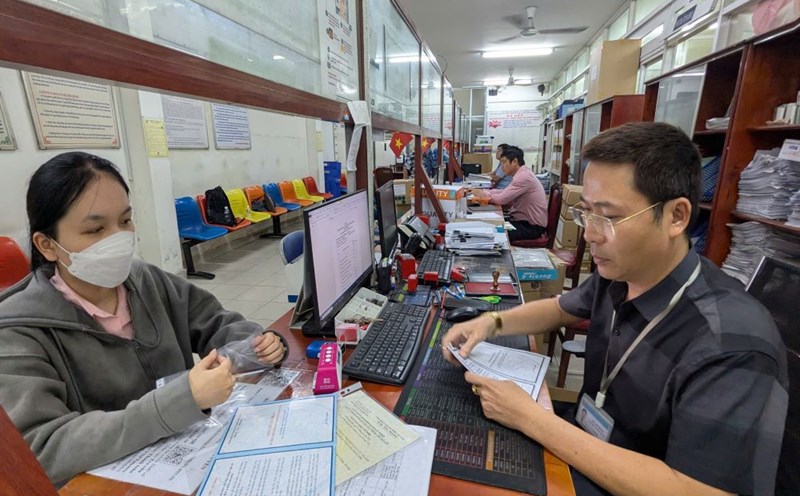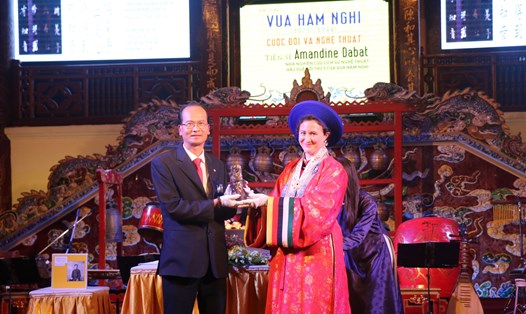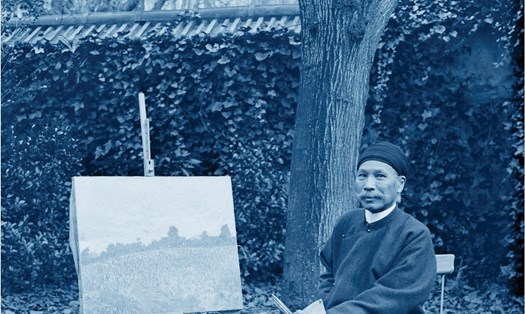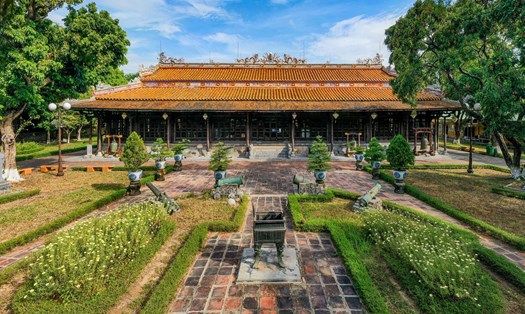The artist's wish for the king's exiled captivity
Choosing for yourself the pseudonym for the spring means "the son of spring", King Ham Nghi has deposited in the art of nostalgia about the homeland and the desire to overtake. Therefore, when borrowing the four poems "Stop stopping the sky/ A piece of love with us" of Mrs. Huyen Thanh Quan to name the exhibition "heaven, young, water" the organizers seemed to have an implication of the feeling of an exiled king.
Viewers seem to be immersed in 21 works of the patriotic king that are displayed solemnly with a high-class artistic lighting effect. And to have an exhibition like this, it is necessary to mention the efforts of art researcher Ace Le and Dr. Amandine Dabat - the 5th generation successor of King Ham Nghi.
Few people know that these works have appeared in the French art market more than 15 years ago from private collections, a linear generation of friends to whom he has given paintings. As fate would have it, Vietnamese collectors have discovered and brought his paintings back, and now have the largest painting exhibition ever by King Ham Nghi.
There, viewers feel like they are immersed in a top-notch art party with a historical comeback journey telling the story of hardship, the passionate nostalgia for the homeland and the love of nature of the king of Vietnam who was sentenced to captivity.
Each work opens a piece in the inner world of King Ham Nghi. We will come across the story through the work of Vue de La Residence D’LR BRIR (the landscape of the mansion in El Bieu) depicts the place where he used to live in Alger, a peaceful corner between exile. Or like the landscape with the Bachon-Saint-Bernard (1906) is the image of a French countryside, where he comes to trips, showing the intersection between reality and nostalgia for his homeland. Meanwhile, the forest bank (Lake Geneva) (1920) has a quiet nuance, with deep -colored colors that evoke the mood of the artist in the vastness of nature.
The emotional reunion of history and art
curator - art researcher and Editor-in-Chief of Art Republik Vietnam Magazine Ace Le commented that King Ham Nghi's paintings are a unique combination of artistic talent and love for the country, where he sent his nostalgia for his homeland and hidden resistance against the pressures during his time in captivity. The former king painted scenes but in fact painted love, both private love and general love.
According to this art expert, it can be affirmed that Ham Nghi is a pioneer and typical example for the approach to Asian - European art interference, absorbing without dissolving, still raising the flag of the identity in its own way. In the Western economy and the market, Ham Nghi and his works have been covered with dust for a long time, and now it is when we need to retell the story in the language and local perspective, as the king has done more than a century ago.
Meanwhile, Mr. Franck Bolgiani, Cultural Abitude of the French Embassy, Director of the French Institute in Hanoi and Deputy Director of the French Institute in Vietnam, said that King Ham Nghi was not only an emperor but also one of the first Vietnamese artists to be properly trained in Western painting. By combining French academic techniques with a deep love for nature and homeland culture, he has created extremely unique works, filled with emotions and filled with nostalgia. Each landscape painting is a delicate self-identity about loneliness, resistance and the beauty of the glorious Vietnamese soul.
Through this exhibition, we have the opportunity to admire the artistic language of an emperor who, even in exiledity, still knows how to revive the memories and culture of the ancient capital, said Mr. Franck Bolgiani.
The special thing about this exhibition that visitors can feel is the emotional reunion between art and history when the works of King Ham Nghi are transported back to the Golden Temple - inside the Hue Imperial Palace. It was like a deep gratitude to the king who was exiled but did not lose his hometown.









